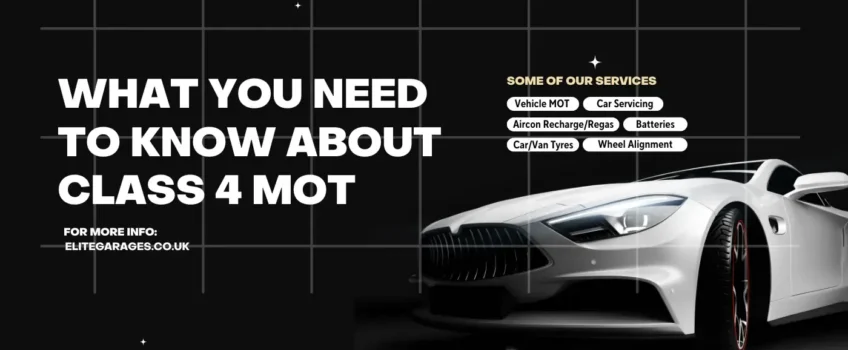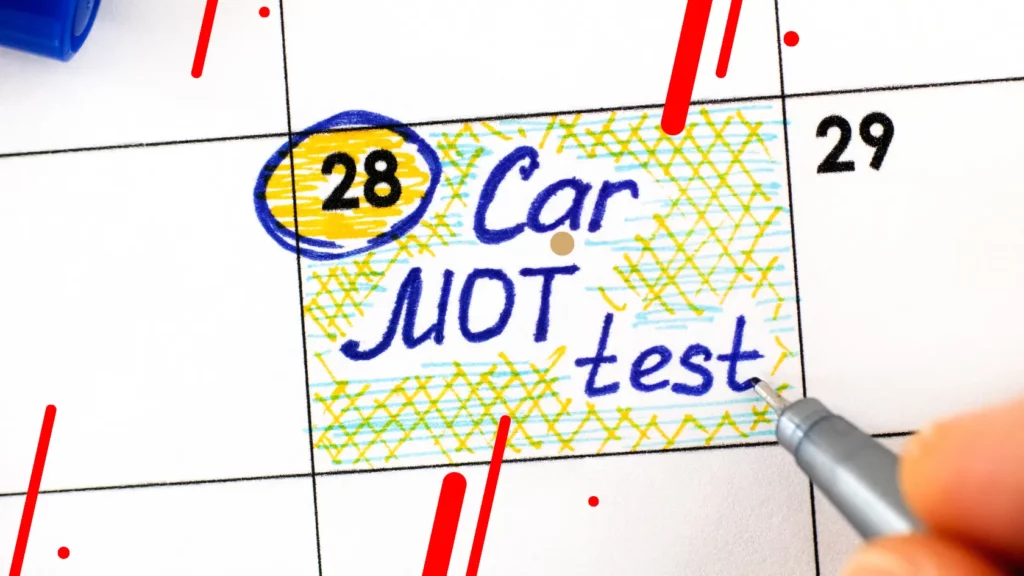
Class 4 MOT Test: Everything You Need to Know About the UK’s Most Common MOT Test
If you own a car or light vehicle in the UK, you’ve likely heard of a Class 4 MOT. This test is essential for ensuring that vehicles meet the safety and environmental standards set by the UK government. It applies to most vehicles, including standard cars, motorhomes, taxis, and vans with a gross vehicle weight (GVW) up to 3,000 kg. In this article, we’ll break down everything you need to know about the Class 4 MOT test, including what it covers, how to prepare for your car MOT, and the importance of keeping track of your MOT due date.
What Vehicles Are Covered by a Class 4 MOT?
As mentioned earlier, a Class 4 MOT is the most common type of test conducted at MOT centres across the UK. It covers a range of vehicles, including the following:
- Cars with up to 8 passenger seats
- Taxis and private hire vehicles
- Ambulances
- Motorhomes
- Vans and light commercial vehicles (up to 3,000 kg)
- Passenger vehicles with up to 12 seats
Whether you’re driving a small car, a taxi, or a motorhome, you’ll need a Class 4 MOT test to ensure your vehicle is safe and roadworthy. If your vehicle fits into one of the categories listed above, it falls under MOT classes that require annual testing once it is three years old.
What Does a Class 4 MOT Cover?
During a Class 4 MOT, your vehicle is thoroughly inspected to ensure it meets the minimum safety and environmental standards. The test covers several crucial areas, including:
- Brakes: Ensuring that your brakes are in good working order and free from significant wear.
- Lights: Testing all lights for proper function and alignment.
- Tyres: Checking tread depth and overall condition to ensure they meet the legal requirements.
- Suspension: Assessing the condition of your vehicle’s suspension for stability and control.
- Emissions: Measuring the levels of emissions from your vehicle to ensure compliance with environmental regulations.
- Seat belts: Ensuring all seatbelts and child restraints are functional and secure.
In addition to these main areas, an MOT also includes a range of other checks on components such as mirrors, wipers, horn, registration plates, and more. It’s essential to keep in mind that the MOT test is only a visual inspection and not a car service.
Failing to maintain these key systems can result in your vehicle failing its MOT. If this happens, you will need to make the necessary repairs before re-taking the test. According to MOT rules, driving without a valid MOT certificate can result in fines and penalties unless you are driving to a pre-booked test.
How to Prepare for Your Class 4 MOT
Once you have found a Class 4 MOT near me, the best way to pass the inspection is to perform basic checks beforehand. Here are some basic checks and maintenance to consider ahead of your MOT test.
1 . Check Lights and Indicators
Faulty lights are one of the most common reasons for MOT failures. Ensure that all headlights, brake lights, indicators, and even the number plate light are working properly. Simple lighting issues can easily lead to a failed MOT but can be resolved quickly if identified early.
2. Test Your Brakes and Handbrake
Brakes are critical for safety, and they are rigorously tested during a Class 4 MOT. If you notice any unusual noises or if the handbrake feels loose, it’s essential to get them checked. Booking a pre-MOT inspection at a trusted garage can help you avoid brake-related MOT failures.
3. Inspect Tyre Tread Depth and Tyre Condition
Worn tyres are another frequent cause of MOT failures. UK law requires a minimum tread depth of 1.6mm, so make sure all tyres, including the spare, are in good condition. Look for cuts or bulges, and if your tyres are nearing the legal limit, it’s time to replace them.
4. Ensure Clear Visibility with Your Windscreen and Wipers
Your windscreen should be free from cracks or chips that obstruct your view, and wipers must be in good working condition. Damaged wipers or a chipped windscreen can easily lead to an MOT failure.
5. Check Exhaust Emissions and Fluid Levels
Ensure your car’s exhaust emissions meet the legal limits and that all essential fluids, such as brake fluid and oil, are topped up. Modern emissions standards are strict, and poor engine performance can lead to failure.
6. Keep Your Car Clean
Although it might seem trivial, keeping your car clean is a simple way to help avoid an MOT failure. Dirt, leaves, and debris can cover critical components like your number plate or brake lights, potentially leading to a failure. Plus, a clean vehicle reflects the care you take in maintaining it, which is a good indicator that it’s likely to be well-maintained overall.
Checking items such as lights, tyres, and brakes can prevent a last-minute scramble to make repairs. By following these steps and maintaining your vehicle regularly, you can greatly improve your chances of passing your Class 4 MOT on the first try.
What Are The Different MOT Classes?
MOT classes are divided based on the type and size of vehicles. A Class 4 MOT covers the most common types of vehicles, including cars, taxis, and motorhomes. Vehicles that do not fall under this category may be subject to different classes of MOT, such as Class 7, which applies to heavier goods vehicles.
If your vehicle is larger than 3,000 kg or has more than 12 seats, it may fall under another class, which requires a different MOT. Always ensure you’re booking the correct test for your vehicle type. We’re already covered a Class 4 MOT but here is a detailed breakdown of the other MOT classes in the UK:
Class 1 and 2 MOT – Motorcycles and Mopeds
- Class 1: Motorcycles with engines up to 200cc.
- Class 2: Motorcycles with engines over 200cc, including motorcycles with sidecars.
These classes are specifically for two-wheeled vehicles. The test covers lights, brakes, tyres, and other essential components to ensure the motorcycle is roadworthy. While motorcycles are generally simpler than cars in terms of mechanical components, safety checks such as steering and suspension are critical.
Class 3 MOT – Three-Wheeled Vehicles (Trikes)
Class 3 includes three-wheeled vehicles, often referred to as trikes, with a weight of up to 450 kg. Like other vehicle types, trikes must pass safety checks for lights, tyres, and brakes, but the test is adapted to suit their unique design and handling characteristics.
Class 5 – Private Passenger Vehicles
Class 5 covers larger passenger vehicles with more than 12 seats, such as minibuses and coaches. These vehicles are typically used for commercial purposes or group transport, making their safety requirements even more stringent. The test ensures that these vehicles are safe for carrying large numbers of passengers, with an emphasis on structural integrity, safety equipment (such as seatbelts), and emission controls.
There are two subclasses within a Class 5 MOT:
- Class 5A: Private passenger vehicles with up to 16 seats.
- Class 5B: Passenger vehicles with more than 16 seats (e.g., buses and coaches).
Class 7 – Goods Vehicles Between 3,000 kg and 3,500 kg
For heavier commercial vehicles like larger vans and trucks that weigh between 3,000 kg and 3,500 kg, a Class 7 MOT is required. These vehicles are usually used for transporting goods, so their MOT checks ensure they can carry heavier loads safely. The test includes inspections of brakes, tyres, suspension, and emissions, with particular attention to weight-bearing components.
Class 5 and HGV MOTs (for Heavier Goods Vehicles)
Vehicles over 3,500 kg, such as heavy goods vehicles (HGVs), fall under separate categories and require different testing, which includes HGV testing rather than the traditional MOT. These tests are more rigorous due to the size, weight, and potential impact of these vehicles on road safety. HGVs must adhere to strict regulations to ensure they are fit to transport goods across long distances.
The Importance of Your MOT Due Date
One of the key aspects of owning a vehicle in the UK is knowing your MOT due date. All vehicles over three years old are required to undergo annual testing, and it is illegal to drive without a valid MOT certificate. According to sources like the DVSA, you should also keep track of your MOT due date. Failing to do so can result in hefty fines, and you may not be legally allowed to drive your vehicle without a valid MOT.
When booking a Class 4 MOT near me, you can also arrange for a pre-MOT check to ensure your vehicle is ready to pass. Many garages, like Elite Garages, offer services that can help identify potential issues before your test date, saving you both time and money. You can also join the Elite Member’s Club to receive FREE MOT and Service Reminders!
What Happens if Your Vehicle Fails a Class 4 MOT?
Unfortunately, not all vehicles pass their Class 4 MOT on the first attempt. In fact, a significant number of MOT failures are due to minor issues like faulty lights or worn tyres. Most MOT failures can be avoided with basic vehicle maintenance and checks before the test.
If your vehicle does fail, it must be repaired and pass a re-test before it can be legally driven again. Failing to do so can lead to penalties, and you may even risk invalidating your insurance. Be sure to address any issues promptly and return for a re-test within 10 days to avoid paying the full test fee again.
Finding A Class 4 MOT Near Me
If you’re searching for a Class 4 MOT near me, choose a reputable garage that specialises in this MOT class and has a track record of delivering reliable, transparent service. Elite Garages has been providing Class 4 MOTs for over 30 years, with a team of skilled technicians to ensure your vehicle is safe and roadworthy. Please note that all of our branches offer MOTs except Strood!
- Bournemouth MOT Centre
- Brighton MOT Centre
- Canterbury MOT Centre
- Caterham MOT Centre
- Deal MOT Centre
- Eastbourne MOT Centre
- Haywards Heath MOT Centre
- Horsham MOT Centre
- Maidstone MOT Centre
- Newport MOT Centre
- Portsmouth MOT Centre
- Pulborough MOT Centre
- Salisbury MOT Centre
- Shaftesbury MOT Centre
- Southampton MOT Centre
- Strood Service Centre (no MOTs)
Do Electric Cars Need An MOT?
Electric cars have become increasingly popular in recent years due to their environmental impact, but do they also need an MOT? The answer is yes. While electric vehicles may not require as many safety checks as traditional combustion engines, they still need regular maintenance and testing to ensure roadworthiness and adherence to emission standards. The same applies to hybrid cars, which use a combination of electric and fuel-powered engines. Hybrid cars will require the same MOT schedule as traditional petrol or diesel vehicles.
Related: What Type of Car Service do I Need?
Why Choose Elite Garages For Your Class 4 MOT
At Elite Garages, we understand how important your vehicle is to you. That’s why we prioritise safety and quality above everything else. Our highly skilled technicians have years of experience in delivering Class 4 MOTs and are trained to identify any potential issues with your vehicle before they become major problems.
In addition to offering Class 4 MOTs, we also provide a comprehensive range of services such as EV and hybrid servicing, tyre replacements and tyre puncture repairs, EV tyres, brake replacements, cambelt replacements, car batteries and more. We strive to provide exceptional customer service and transparent pricing so that you can trust us with all your vehicle needs.
If you’re looking for a reliable Class 4 MOT near me, be sure to choose a garage that provides thorough, transparent testing. Don’t risk failing your Class 4 MOT – book yours today at Elite Garages!
FAQS
Click the + to read any answer or visit our most FAQ page to review the most frequently asked questions across all our Elite Locations.
If you click on a ‘Category’ or ‘Tag’ link, the page will ‘refresh’ and reload the page showing the top of the page first, you’ll then just need to scroll down to the FAQ section to see the results for the Category or Tag you selected.
Driving without a valid MOT is illegal in the UK. If caught, you could face a fine of up to £1,000. Additionally, if you’re involved in an accident, your insurance could be invalidated, and you may be liable for damages. The only exception is driving to a pre-booked MOT appointment. To avoid this risk, ensure you schedule your MOT before your MOT due date.
A Class 4 MOT checks various components of your vehicle to ensure it meets the UK’s safety and environmental standards. The test includes an inspection of the brakes, lights, tyres, suspension, emissions, and more. If any of these components do not meet the legal requirements, your vehicle will fail the test, and you’ll need to have repairs done before re-testing. Ensuring these components are regularly maintained will help you pass the MOT without any issues.
A Class 4 MOT covers standard vehicles like cars, taxis, and motorhomes with a gross vehicle weight (GVW) of up to 3,000 kg, making it the most common type of MOT test. A Class 7 MOT, on the other hand, is required for heavier commercial vehicles that weigh between 3,000 kg and 3,500 kg, such as large vans and trucks. Both classes check safety features, emissions, and roadworthiness, but Class 7 includes stricter weight-bearing component inspections due to the heavier loads carried by these vehicles.
You can find your MOT due date by checking the MOT certificate provided after your last test, or by using online tools like the government’s MOT check service. Vehicles over three years old must undergo an MOT test annually. It’s important to keep track of this date, as driving without a valid MOT is illegal unless you’re going to a pre-booked test. Many garages and online services offer MOT reminders to ensure you don’t miss your MOT due date. You can sign up for the Elite Members Club to receive your MOT and service Reminders!
About Us
Opening Times
Saturday : 8:30–4:00
Sunday : closed
More Information
Contact UsCustomer Information Pack
Check MOT Due Date
Free MOT reminder
Careers




